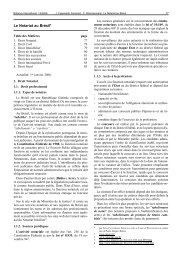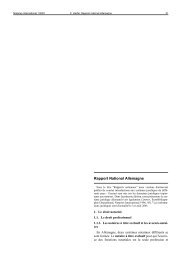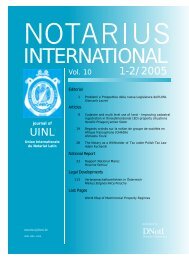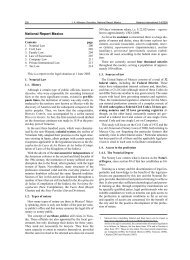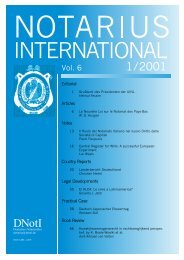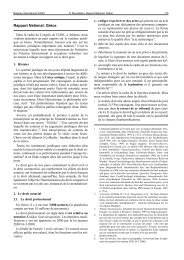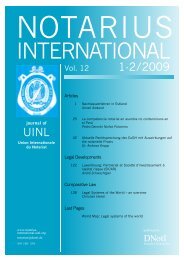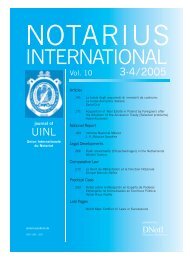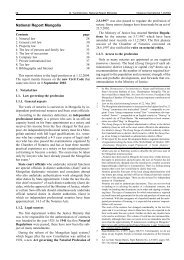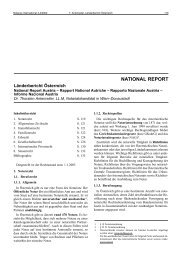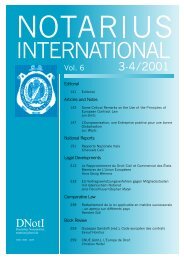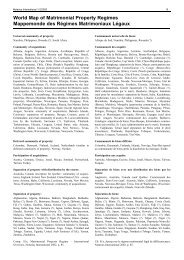ARTICLES and NOTES - Notarius International
ARTICLES and NOTES - Notarius International
ARTICLES and NOTES - Notarius International
Create successful ePaper yourself
Turn your PDF publications into a flip-book with our unique Google optimized e-Paper software.
198 F. Tassinari, Reform of the limited liability company in Italy <strong>Notarius</strong> <strong>International</strong> 3-4/2002<br />
during the 1920s. The new model was strongly dependent<br />
on the share form in that the main personal elements<br />
contained in the earlier bills were ab<strong>and</strong>oned <strong>and</strong>, indeed,<br />
some of the new aspects finalised on the launch of the<br />
new company type were then also extended to the share<br />
company.<br />
The Bill’s punctum dolens however, then introduced into<br />
the Code provisions was above all, the renunciation<br />
of a truly autonomous legislative scheme for the S.r.l.<br />
This was because the legislative technique used for each<br />
different element, was a generic reference („so far as<br />
compatible“) to the rules laid down for the corresponding<br />
aspect of the share company for all matters not expressly<br />
provided for in the related sedes materiae 14 .<br />
Furthermore, with the final approval of the final text of<br />
the draft of Book V of the Italian Civil Code, other new<br />
distinctive aspects of the S.r.l. as against the share company<br />
were withdrawn (e.g. maximum limit of capital,<br />
registration of quotas in the Business Register <strong>and</strong> subsidiary<br />
liability of members on the basis of the German<br />
model etc.). Such changes were based on the legislature’s<br />
second thoughts, often of a hurried nature 15 . On the other<br />
h<strong>and</strong> the reference to the rules governing the share<br />
company as a whole (so long as compatible) were eliminated<br />
with the insertion instead, of a number of specific<br />
references to individual Articles or, indeed, individual<br />
paragraphs of specific Articles.<br />
In conclusion therefore, in the final text of Articles<br />
2472 et seq. of the Italian Civil Code, the S.r.l. is undoubtedly<br />
presented more as a small company with<br />
share capital than a new intermediary form situated<br />
somewhere between a company with shares <strong>and</strong> a personal<br />
company. The only clear difference with respect to<br />
the reference model is the bar against the issue of shares<br />
(<strong>and</strong> of debenture stock) <strong>and</strong> the autonomous legislative<br />
scheme dealing with the quota share which such bar implies<br />
of necessity.<br />
2. The Evolution of the S.r.l. <strong>and</strong> attempts at its<br />
emancipation from the share model<br />
2.1. The failure to exploit the particular qualities of<br />
the S.r.l.<br />
The final version of Articles 2472 et seq. of the Italian<br />
Civil Code of 1942, with the extensive sequence of references<br />
to the rules governing the S.p.A. (the share company)<br />
such rules thus governing both forms, has had a<br />
lengthy influence over Italian doctrinal teaching, case<br />
law <strong>and</strong> operators in the field generally. It has induced an<br />
almost completely uncritical acceptance of the direction<br />
traced by the drafters of Book V of the Civil Code.<br />
Apart from the absence of shares <strong>and</strong> the consequential<br />
need to draw up a complete theoretical framework for the<br />
concept of the company quota <strong>and</strong> its various transformations,<br />
the legal characteristics peculiar to the S.r.l. legislative<br />
scheme have been essentially minimised (size of<br />
quotas for General Meetings under Article 2486(1) of the<br />
old text of the Civil Code, company rights in the event of<br />
capital reduction due to losses under Article 2494(3) of<br />
the old text), to say nothing of those occasions when the<br />
provisions have been completely emptied of their content<br />
(for instance, the beginning of Article 2492 of the Civil<br />
Code old text, under which entitlement to profits is based<br />
on the proportion of the share capital subscribed to, „save<br />
as may be provided otherwise under the Articles of Association“).<br />
From this perspective, the failure to make a cross reference<br />
to a rule applicable to the share based Company<br />
did not preclude its application by analogy, even<br />
where immediately subsequent provisions were so referred<br />
to, even in sequence. One such example is the failure<br />
to make a cross reference in Article 2487 of the old<br />
text of the Civil Code to Article 2383(2).<br />
In its best thought out theoretical form, failure to crossrefer<br />
to a particular provision applying to the S.p.A.<br />
(share company) (apart from the subjects of shares <strong>and</strong><br />
debentures) did not in any way preclude recourse to analogy<br />
by the interpreter. On this account it simply meant<br />
that the legislature had not wished to resolve the problem<br />
expressly, indeed, giving this job to the interpreter in order<br />
to confirm the pre-requisites for the existence of the<br />
analogy itself 16 .<br />
The Italian S.p.A. is governed by the provisions of<br />
Book V of the Italian Civil Code. Set out as these provisions<br />
are under a Head which comes before the provisions<br />
governing the S.r.l., there can be no doubt that the<br />
S.p.A. remained the prototype for the capital company<br />
for a number of decades.<br />
2.2. The Exploitation of the special characteristics of<br />
the S.r.l. through the absence of legal cross-reference<br />
The first attempt of significance in Italy to emancipate<br />
the S.r.l. from its historical subjection to the S.p.A. was<br />
effected in academic tracts 17 which, taking their lead<br />
from the study of the holding of interests in companies,<br />
elaborated a general rule concerning the application by<br />
analogy of the rules governing companies with shares,<br />
based on the weight to be given from time to time to the<br />
failure to provide an express cross-reference.<br />
The doctrine in question can be expressed in the following<br />
terms:<br />
Since the legislative policy intended by the 1942 legislature<br />
was clear with reference to the S.r.l., in particular<br />
the desire to position the new company type by the side<br />
14 G.C.M. Rivolta, op. cit., p. 33.<br />
15 In this context the words of G.C.M. Rivolta, op. cit., p. 35, appear fully<br />
justified, even in the light of only a summary historical analysis<br />
(but also in the light of a comparative analysis) when he states that it<br />
is not possible to see in the foundations of the s.r.l. "a constant <strong>and</strong><br />
uniform trend driven by precise <strong>and</strong> homogeneous requirements. In<br />
fact, quite the opposite was true. The introduction of our form of<br />
company followed an unsteady, <strong>and</strong> in some respects, a contradictory<br />
path under the pressure of differing interests, at times of only a temporary<br />
nature, behind which one can often see the desire simply to<br />
emulate foreign models".<br />
16 See on this, representative of all, G. Santini, op. cit., p. 11: "save<br />
where there are special reasons (which will be examined from time to<br />
time in this commentary) the interpreter is therefore justified in having<br />
recourse to the legislative scheme laid down for the prototype<br />
share company".<br />
17 G.C.M. Rivolta, op. cit.; <strong>and</strong>, before that, La partecipazione sociale,<br />
Milan, 1964.



